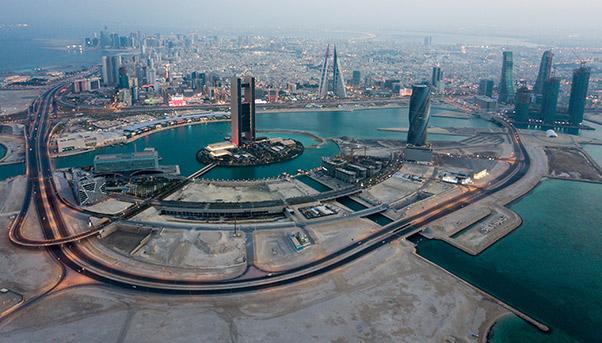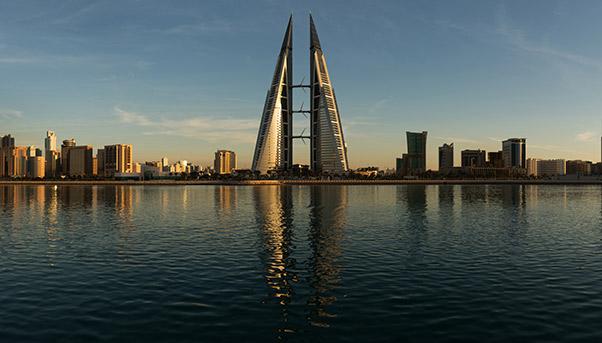
There’s always a long line to get to the top of the King Fahd Causeway Restaurant. Especially during the weekends, when tourists from Saudi Arabia crowd into the small elevator that brings them up into the tower. The atmosphere is made even more surreal by the fact that the building looks like an air traffic control tower. But there are no airplanes here, just sand and water as far as the eye can see.
Once the elevator arrives at the restaurant’s terrace it is easy to see why the line is so long: the view takes in the entire 25 kilometres of highway that connects the archipelago of Bahrain to the coast of Saudi Arabia. The Causeway Restaurant is one of the most unusual places to eat, sitting right on the border between Bahrain and Saudi Arabia. What is even more exotic is that it is an artificial border, built on a highway stretching over the sea that connects this Lilliput state in the Persian Gulf (it’s only 765 square kilometers) with its much giant neighbor Saudi Arabia.
The plan for building this highway – which resembles the one in the Florida Keys over the brief stretch where the sea is shallow and looks more like a lagoon – was born in 1965. Construction started in 1981 and the King Fahd Causeway (named in honor of King Fahd of Saudi Arabia) was inaugurated in 1986 with an investment of $800 million (worth about $1.2 billion in today’s dollars). The Caseway is a small masterpiece of engineering: 14 kilometers of viaducts and 5 bridges requiring 350,00 square metres of cement reinforced with 47,000 tonnes of steel, according to its website.
A new highway across the sea
Today the “Switzerland of the Persian Gulf” is in the middle of a construction boom, driven by a growing economy and a desire to close a gap with other Gulf countries, particularly Abu Dhabi and Doha. That could also be why Bahrain today seems like one of the most dynamic countries in the region. And this new dynamism is symbolized by a new highway on the sea: 30 years after the completion of the first engineering work that was greeted as a design miracle, a second causeway is now on the drawing board. Bahrain will double its links to the mainland by building a second highway. Khalid Al-Rumaihi, the CEO of the Bahrain Economic Development Board, greeted the new project as an enormous boost for the economy.
«The causeway is a massive source of tourism, and it’s something we’d like to capture» said Al-Rumaihi to the Arab News news agency.
Infrastructure to boost tourism
Although its population in just barely 1.3 million people, Bahrain was visited by over 12 million people in 2016, 8 million of which arrived across the Saudi border.
Infrastructure plays a decisive role in this increase: according to the government agency Bahrain Tourism and Exhibitions Authority, traffic crossing the King Fahd Causeway rose 11.87% and entries from the Khalifa bin Salman Port rose 23.2%. These figures confirm the strategic value of the new highway, which will cost $4 billion-$5 billion. Construction will take 4 years, and will include a rail link connecting Bahrain to Saudi Arabia (to Jeddah and Riyadh in particular.)

Therefore Bahrain’s biggest need – given that its water surface area surpasses its land mass – is infrastructure. That’s why the capital city of Manama is a huge building site, with a skyline that is starting to look like Dubai and Abu Dhabi and is now full of cranes. Most of them are along the Arad Highway, which borders the area where construction on the new airport is underway.
The Bahrain International Airport is undergoing a massive overhaul of all passenger spaces, starting with the exterior and parking for 7,000 cars. A new terminal is being built from zero with new interiors with lots of retail space: 1,000 square meters of duty free and mono-brand stores in the arrivals area. When construction is finished in 2020, the airport will be four times its current size, with 220,000 square meters surface area and all of the characteristics of an intercontinental airport organized to welcome the tourists that Bahrain aims to attract. The airport’s web site says the short term goal is to increase passenger traffic from 9 million to 14 million, who will come and go at 24 gates, each equipped with jetties, and pass through 36 passport control booths on arrival.
International financing for infrastructure
The total investment is over $1.1 billion, of which only a small part is being spent by Bahrain. The main part of the funding, $919 million, comes from the Abu Dhabi Fund for Development, which has earmarked $2.5 billion to support a sort of Marshall Plan launched by Abu Dhabi, capital of the United Arab Emirates, to boost development of this Gulf country.
The economy of Bahrain, which currently gets only 3.7% of its GDP from tourism, will benefit from this development. With a strategy that bets on infrastructure to create the great transport routes capable of opening the doors of this small state to tourism and global business flows.

